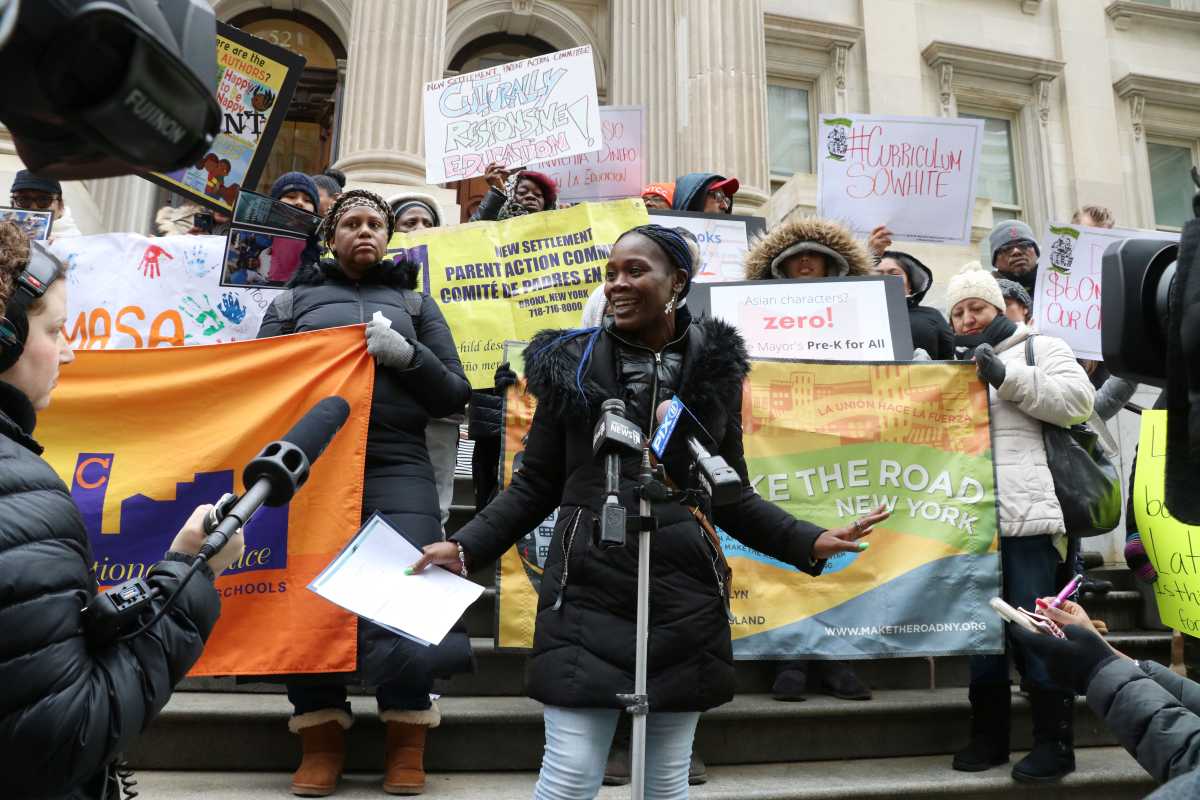The Coalition for Educational Justice, a parent-led educational advocacy group, called on Mayor Bill de Blasio Wednesday to invest $60 million in the city budget for a new, more culturally inclusive reading curriculum.
“Budgets are moral documents, we say what we believe to me most important when we set up a budget,” said Natasha Capers, coordinator for CEJ.
The nonprofit organized a rally outside of the steps of the Tweed Courthouse just a few hours after releasing a report on an extreme lack of author and character diversity within the city school’s reading lists.
For every 10 books that students from 3-k to the 8th grade are exposed to, the report found, eight are written by white authors. Not only were the majority of the authors white, the majority of main characters in the books were white as well.
CEJ sifted through 1,205 books from 15 commonly used book lists and found that more than half of the books centered on a white character. Only 15 percent of the city’s student population is white.
The nonprofit released a similar report in February about the disparity between the number of students of color in the city and the number of elementary school books written by authors of color. Like in the report released on Wednesday, that report found that 84 percent of books that an elementary school student could easily be exposed to in school were written by white authors.
Wednesday’s report expanded on those finding. Stating that out of the books reviewed 93 percent of middle school level books and 92 percent of books for 3-K and Pre-K students were written by white authors. In addition, 55 percent of those 3-K and Pre-K books centered on a white main character, and of those books featuring a person of color, the author was usually white.
On the Scholastic booklist, every book focused on a main character of color was written by a white author. Every book with a Black or Asian protagonist on the Pre-K 4 All curriculum and NYC Reads 365 booklist was also written by a white author. Of the 22 books with Black main characters on the 3-K Explorations Curriculum, 20 were written by white authors.
“I didn’t know who Toni Morrison, a great African-American author, was until I was a grown woman, but I knew what ‘To Kill a Mockingbird’ was,” said Tanesha Grant from CEJ. “To Kill a Mockingbird,” a novel focused on prejudice in 1930s Alabama, was written by Harper Lee, a white woman.
A lack of exposure to black authors and historical figures during her school years made Grant believe that only white people did anything of value. A lack of representation is dangerous, advocates said, that ultimately results in internalized racism and low self-worth.
“It’s even deeper than ethnic identity and racial identity,” said Capers, who added that there were virtually no books featuring a main character with a disability or who were gender non-conforming. Ideally students in the city would be exposed to a vast number of books about and by all types.
Representatives from the Department of Education said that the agency’s Division of Early Childhood Education is conducting an audit of recommended book lists to ensure “they are reflective of urban life, written by diverse authors and contain characters with diverse traits including race, gender, ability and family structure.” A new book lists is expected to be released in January of next year.
DOE spokesperson also said that a new NYC 365 booklist will be released this month which will include book selected by parents, teachers, students, members of CEJ and staff at the Department of Literacy and other offices of the Division of Teaching and Learning.
In September, Chancellor Carranza announced the beginning of a push for culturally responsive education, a pedagogy that recognizes the importance of including students’ cultural references, in schools. Later that month, Carranza hired 60 Culturally Responsive-Sustaining Education Fellows to help create such a curriculum.
But advocates don’t think that change is happening quickly enough and that the city needs to be more aggressive in choosing to not purchase from curriculum providers that did not meet new diversity standards.
“But let’s start, let’s say what we think is important and put our money where our mouth is,” said Capers.






































